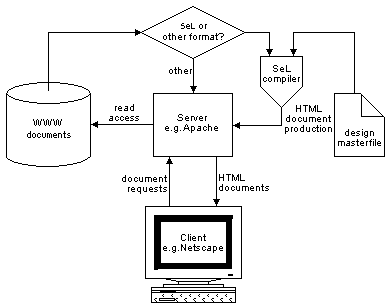
 Diese Seite auf Deutsch.
Diese Seite auf Deutsch. |
 Diese Seite auf Deutsch. Diese Seite auf Deutsch. |
Version 1 of the authoring frontend SeSAMe was developed at the University of Kassel 1998. It
is based on SeL data processing. The idea is that WWW authors use SeSAMe to create document
contents whereas the university's PR department provides the design for those documents.
SeL allows separate storage of document design and document content and it is best used with only a few
central design templates and lots of (content) documents. Once a WWW server runs SeL, minor or major redesign projects are done very easily without changing thousands of documents manually. Beyond
design and content, other formal document elements (such als methodological behaviour in online learning environments) can be treated separately as well.
Introduction
The SeSAMe Language (SeL) is developed and used at the University of Kassel (Germany) since 1998. It is best
suited as a real time text filter. Therefore, it can be used to modify and convert source code dynamically.
Currently, SeL is used by a number of institutions mainly in WWW/HTML contexts. Problems in this
field were the initial reason to develop SeL. This is why today SeL is most useful in WWW publishing
contexts. Nevertheless, it should easily be possible to use SeL to process other plain text document
description languages than HTML (LaTeX, XML, WAP etc.) to modify and/or convert them to each other
(as well as to their different specifications and standards).![]()
Content file and masterfile
We call the SeL content files (provided by WWW authors) *.ghk files but on other SeL hosts this naming
convention can be adapted to local ideas (e.g. *.sel). These files contain logically expressed content elements.
Centrally stored "masterfiles" contain descriptions of the content behaviour. When a *.sel file is
served, the requested *.sel file, followed by a masterfile are sent to the SeL interpreter which
sees both files as one single data stream.
![]()

Technically, in this stream, the *.ghk file part contains SeL variable declarations for the program body
contained in the masterfile part. This is done whenever a document is requested and (at least this is
the way we use SeL) an HTML output is generated and sent to the client. The SeL interpreter is an
add-on for WWW servers (only Apache has been seriously tested yet).